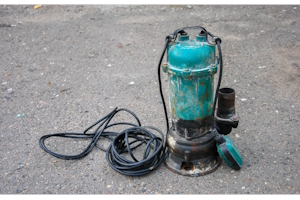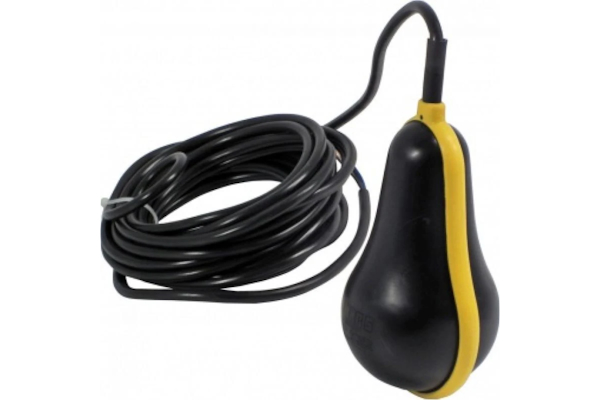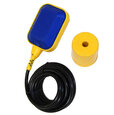Sewage Pump Float Switch Explained

Figure 1: A submersible sewage pump with attached float switch
A sewage pump float switch is an electromechanical device that automatically controls a sewage pump by moving with the liquid level in a basin, turning the pump on or off as needed. This automation prevents overflow, reduces manual monitoring, and protects the pump from damage due to dry runs, thereby extending its lifespan and improving energy efficiency. This guide covers the operation, installation, troubleshooting, and repair of sewage pump float switches.
Table of contents
- Sewage pump float switch operating principle
- Selecting a sewage float switch
- How to install a sewage pump float switch
- Troubleshooting a sewage pump float switch
- When to repair a sewage pump float switch
- FAQs
View our online selection of float switches!
Sewage pump float switch operating principle
A sewage pump float switch, which is a type of tether float switch, fastens to the discharge pipe approximately 100 - 150 mm (4" - 6") above the pump's motor. This setup is similar to how a septic tank pump float operates. This ensures that the float switch will float above the pump's minimum liquid level, and the pump will be turned on before the sewage overflows the basin. Typically, tether float switches have an electromechanical reed switch and magnet inside. A simple reed switch has two metal contacts sealed inside a glass tube. In a non-magnetized state, these contacts can be touching (normally closed) or not (normally open). When a permanent magnet moves over the contacts, they will move to the opposite state (closed to open or vice versa). When the magnet moves away, the contacts revert to their normal state.
Suppose the sewage level in a basin rises high enough to tilt the float switch 45° above horizontal. In that case, the magnet within the switch slides over and operates the reed switch. In a typical configuration, the reed switch is open until this point. When the reed switch closes, an electrical current can flow through it and signal the sewage pump to turn on. When the sewage level in the basin drops and the float switch tilts to 45° below horizontal, the magnet slides away from and opens the reed switch, signaling the sewage pump to turn off.
Selecting a sewage float switch
There are three aspects to consider when choosing between float switches for a sewage pump septic pump float switch:
- Material: Sewage is highly corrosive. Therefore, choose a float switch with a PVC or Polypropylene casing. MAC5 float switches are suitable, whereas MAC3 are not primarily because MAC5 switches have a specific tilting design that handles the turbulence of sewage better than MAC3 switches.
- Power: In a typical configuration, the pump's power flows through the septic tank float switch. Therefore, know the electrical load in the system. Ensure that the wattage, voltage, and amperage do not exceed the max capabilities of the reed switch. For example, a 1/2 horsepower pump operating at 115 volts draws a 9.8 amperes load. Multiply these two values together to get the wattage - 1127 watts. None of these three values should exceed the maximum capability of the reed switch.

Figure 2: A MAC5 ATEX sewage float switch
How to install a sewage pump float switch
Before installing a float switch in a sewage system, understand these two factors: power connection and application.
- Power connection: Float switches may or may not come with a piggyback plug. The switch's piggyback plug can plug into an outlet, and the pump plug can plug into the back of the piggyback plug. If it does not have a piggyback plug, a float switch must be hardwired to a control panel and the pump. The control panel's neutral and ground wires connect directly to the pump's neutral and ground wires. One wire from the float switch connects to the control panel's hot wire, and the other connects to the pump's hot wire. It is normal for the float switch's wires to be white and black. However, both are considered black when connected to the hot wires.
-
Application: Float switches have two applications in a sewage system: operating the pump and controlling an alarm. Alarm control switches are typically narrow-angle float switches, meaning they only need to rise or dip 10° above or below the horizontal to sound an alarm.
- High-level alarm switches: These switches should be normally open down, meaning they must rise 10° to close and activate the alarm. Install these sewage floats higher up the pump's discharge pipe.
- Low-level alarm switches: Low-level switches should normally open up, meaning they close when the switch falls 10°.
Troubleshooting a sewage pump float switch
When a sewage pump float switch malfunctions, it can lead to serious issues such as pump failure, overflow, or dry running. Here are some steps to troubleshoot common problems with sewage pump float switches:
- Check for physical obstructions: Ensure that the float switch is not tangled with any debris or obstructed by the basin walls, and clean the basin to remove any sludge, grease, or solid waste that might be hindering the movement of the float switch.
- Test the float switch mechanism: Lift the float switch manually to see if it activates the pump and listen for a clicking sound, which indicates that the internal reed switch is operating.
- Electrical testing: Ensure all electrical connections are secure and free from corrosion, and use a multimeter to test the continuity of the float switch by placing the probes on the float switch terminals and tilting the float switch to see if the continuity changes.
- Inspect the float switch cable: Check the cable for any signs of wear, cuts, or damage, and ensure that the cable entry point is sealed properly to prevent water from entering and causing short circuits.
- Evaluate the pump operation: Observe the pump's response when the float switch activates to determine if the issue might be with the pump itself, and check the control panel for any error codes or indicators if the float switch is hardwired.
When to repair a sewage pump float switch
If troubleshooting reveals that the float switch is faulty, you may need to repair or replace it. Here are the steps to repair a sewage pump float switch:
- Safety first: Always disconnect the power supply before attempting any repairs to avoid electrical shock, and wear appropriate protective gear, including gloves and safety glasses.
- Replace the float switch: Disconnect the old float switch from the pump or control panel, and if it has a piggyback plug, simply unplug it; for hardwired switches, carefully disconnect the wires. Connect the new float switch in the same manner as the old one, plugging the new switch into the outlet and then plugging the pump into the back of the switch for piggyback plugs, or connecting the wires according to the manufacturer's instructions for hardwired switches.
- Seal and secure: Ensure that the cable entry point is sealed properly to prevent water ingress, using waterproof connectors or sealant as necessary, and position the float switch at the correct height on the discharge pipe, ensuring it can move freely without obstructions.
- Test the new installation: Manually lift and lower the float switch to ensure it activates and deactivates the pump correctly, then restore power and observe the float switch during a normal pump cycle to confirm it operates as expected.
- Regular maintenance: Regularly inspect and clean the sewage basin and float switch to prevent future issues, and periodically test the float switch and pump operation to ensure they are functioning correctly.
FAQs
What is a sewage pump float switch?
A sewage pump float switch automatically operates the pump by using liquid level information. When the level is high, the float switch turns the pump on. When the level drops down enough, the float switch turns the pump off.
How can a sewage float switch be tested?
If the pump is not running, pull the float switch up. If the pump turns on, the float switch is still operational.
How can a float switch fail?
A float switch fails if it's unsuitable for the system or incorrectly rated for power usage. For instance, a non-corrosion-resistant metal float switch is unsuitable for a sewage system.





